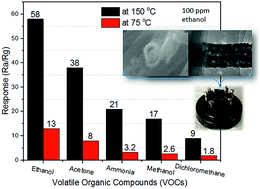Tube in tube ZnO/ZnCo2O4 nanostructure synthesized by facile single capillary electrospinning with enhanced ethanol gas-sensing properties
Abstract
ZnO/ZnCo2O4 tube in tube nanostructures were successfully fabricated by single capillary electrospinning technology and calcination treatment. The tube in tube nanostructure was achieved via adjustment of the heating ratio during the calcination process. The composition and nanostructure of ZnO/ZnCo2O4 tube in tube were characterized by X-ray diffraction (XRD), scanning electron microscopy (SEM), transmission electron microscopy (TEM), high resolution transmission microscopy (HRTEM), Brunauer–Emmett–Teller (BET), and X-ray photoelectron spectroscopy (XPS). Excellent gas sensing performance of the structure was observed, with high response (58) of as-prepared material toward 100 ppm ethanol vapor at an optimal temperature of 150 °C. Rapid response time (5.6 s) and recovery time (4.8 s) were recorded at this optimal temperature. Noticeable response (13) was also observed of 100 ppm ethanol vapor at 75 °C. The tube in tube nanostructure, n–p heterojunction, and oxygen vacancies are potential reasons for the excellent gas sensing performance. The sensing mechanism of the as-prepared ZnO/ZnCo2O4 n–p heterostructure toward ethanol vapor was discussed.



 Please wait while we load your content...
Please wait while we load your content...